Identification of Critical Source Areas of Nitrogen Load in the Miyun Reservoir Watershed under Different Hydrological Conditions
Abstract
1. Introduction
2. Materials and Methods
2.1. Study Area Description
2.2. Data Sources
2.3. Data Processing
2.4. Model Parameter Analysis, Calibration, and Verification
2.5. Statistical Analysis Method
2.6. Zonation Method for Nitrogen Load
3. Results and Analysis
3.1. Model Parameter Analysis, Calibration and Verification
3.2. Temporal Characteristics of Nitrogen Load
3.3. Spatial Characteristics of Nitrogen Load
3.4. Preliminary Zonation of Nitrogen Load in Different Hydrological Conditions
4. Discussion
4.1. Identification of Key Impact Factors
4.2. Comparison of Zonation Methods of Risk Source Areas
4.3. Nitrogen Load Final Zonation Results
5. Conclusions
Author Contributions
Funding
Acknowledgments
Conflicts of Interest
References
- Carpenter, S.R.; Caraco, N.F.; Correll, D.L.; Howarth, R.W.; Sharpley, A.N.; Smith, V.H. Nonpoint pollution of surface waters with phosphorus and nitrogen. Ecol. Appl. 1998, 8, 559–568. [Google Scholar] [CrossRef]
- Sun, B.; Zhang, L.; Yang, L.; Zhang, F.; Norse, D.; Zhu, Z. Agricultural non-point source pollution in China: Causes and mitigation measures. Ambio 2012, 41, 370–379. [Google Scholar] [CrossRef] [PubMed]
- Yang, Y.; Chen, Y.; Zhang, X.; Ongley, E.; Zhao, L. Methodology for agricultural and rural NPS pollution in a typical county of the North China Plain. Environ. Pollut. 2012, 168, 170–176. [Google Scholar] [CrossRef] [PubMed]
- Shen, Z.; Liao, Q.; Hong, Q.; Gong, Y. An overview of research on agricultural non-point source pollution modelling in China. Sep. Purif. Technol. 2012, 84, 104–111. [Google Scholar] [CrossRef]
- Sun, C.; Chen, L.; Zhai, L.; Liu, H.; Jiang, Y.; Wang, K.; Jiao, C.; Shen, Z. National assessment of spatiotemporal loss in agricultural pesticides and related potential exposure risks to water quality in China. Sci. Total Environ. 2019, 677, 98–107. [Google Scholar] [CrossRef]
- Edwin, D.O.; Zhang, X.; Yu, T. Current status of agricultural and rural non-point source Pollution assessment in China. Environ. Pollut. 2010, 158, 1159–1168. [Google Scholar]
- Shen, Z.; Qiu, J.; Hong, Q.; Chen, L. Simulation of spatial and temporal distributions of non-point source pollution load in the Three Gorges Reservoir Region. Sci. Total Environ. 2014, 493, 138–146. [Google Scholar] [CrossRef]
- Rathnayake, U. Migrating storms and optimal control of urban sewer networks. Hydrology 2015, 2, 230–241. [Google Scholar] [CrossRef]
- Wang, X.; Li, Z.; Li, M. Impacts of climate change on stream flow and water quality in a drinking water source area, Northern China. Environ. Earth Sci. 2018, 77, 1–14. [Google Scholar] [CrossRef]
- Shortle, J.; Horan, R.D. Nutrient pollution: A wicked challenge for economic instruments. Water Econ. Policy 2017, 3, 1650033. [Google Scholar] [CrossRef]
- Xiang, C.; Wang, Y.; Liu, H. A scientometrics review on nonpoint source pollution research. Ecol. Eng. 2017, 99, 400–408. [Google Scholar] [CrossRef]
- Yang, Q.; Liu, J.; Zhang, Y. Decoupling agricultural nonpoint source pollution from crop production: A case study of Heilongjiang land reclamation area, China. Sustainability 2017, 9, 1024. [Google Scholar] [CrossRef]
- Tripathi, M.P.; Panda, R.K.; Raghuwanshi, N.S. Development of effective management plan for critical subwatersheds using SWAT model. Hydrol. Process. 2005, 19, 809–826. [Google Scholar] [CrossRef]
- Huang, L.; Ban, J.; Han, Y.T.; Yang, J.; Bi, J. Multi-angle indicators system of non-point pollution source assessment in rural areas: A case study near Taihu Lake. Environ. Manag. 2013, 51, 939–950. [Google Scholar] [CrossRef] [PubMed]
- Huang, X.; Ma, J.X. Changes in the ecosystem service values of typical river basins in arid regions of Northwest China. Ecohydrology 2013, 6, 1048–1056. [Google Scholar] [CrossRef]
- Shore, M.; Jordan, P.; Mellander, P.E.; Kelly-Quinn, M.; Wall, D.P.; Murphy, P.N.C.; Melland, A.R. Evaluating the critical source area concept of phosphorus loss from soils to water-bodies in agricultural catchments. Sci. Total Environ. 2014, 490, 405–415. [Google Scholar] [CrossRef]
- Tim, U.S.; Mostaghimi, S.; Shanholtz, V.O. Identification of critical nonpoint pollution source areas using geographic information systems and water quality modeling. JAWRA J. Am. Water Resour. Assoc. 1992, 28, 877–887. [Google Scholar] [CrossRef]
- Ockenden, M.C.; Deasy, C.; Quinton, J.N.; Surridge, B.; Stoate, C. Keeping agricultural soil out of rivers: Evidence of sediment and nutrient accumulation within field wetlands in the UK. J. Environ. Manag. 2014, 135, 54–62. [Google Scholar] [CrossRef]
- Wang, F.; Sun, Z.; Zheng, S.; Yu, J.; Liang, X. An integrated approach to identify critical source areas of agricultural nonpoint-source pollution at the watershed scale. J. Environ. Qual. 2018, 47, 922–929. [Google Scholar] [CrossRef]
- Ouyang, W.; Huang, H.; Hao, F.; Guo, B. Synergistic impacts of land-use change and soil property variation on non-point source nitrogen pollution in a freeze-thaw area. J. Hydrol. 2013, 495, 126–134. [Google Scholar] [CrossRef]
- Zhang, S.; Xia, C.; Li, T.; Wu, C.; Deng, O.; Zhong, Q.; Xu, X.; Li, Y.; Jia, Y. Spatial variability of soil nitrogen in a hilly valley: Multiscale patterns and affecting factors. Sci. Total Environ. 2016, 563–564, 10–18. [Google Scholar] [CrossRef] [PubMed]
- Chen, L.; Dai, Y.; Zhi, X.; Xie, H.; Shen, Z. Quantifying nonpoint source emissions and their water quality responses in a complex catchment: A case study of a typical urban-rural mixed catchment. J. Hydrol. 2018, 559, 110–121. [Google Scholar] [CrossRef]
- Gabriel, M.; Knightes, C.; Cooter, E.; Dennis, R. The impacts of different meteorology data sets on nitrogen fate and transport in the SWAT watershed model. Environ. Model. Assess. 2014, 19, 301–314. [Google Scholar] [CrossRef]
- Behera, S.; Panda, R.K. Evaluation of management alternatives for an agricultural watershed in a sub-humid subtropical region using a physical process based model. Agric. Ecosyst. Environ. 2006, 113, 62–72. [Google Scholar] [CrossRef]
- Liu, R.; Zhang, P.; Wang, X.; Chen, Y.; Shen, Z. Assessment of effects of best management practices on agricultural non-point source pollution in Xiangxi River watershed. Agric. Water Manag. 2013, 117, 9–18. [Google Scholar] [CrossRef]
- Bello, A.; Amin, D.; Haniffah, M.R.M.; Hanapi, M.N.; Usman, A.B. Identification of critical source areas under present and projected land use for effective management of diffuse pollutants in an urbanized watershed. Int. J. River Basin Manag. 2019, 17, 171–184. [Google Scholar] [CrossRef]
- Cecchi, G.; Munafò, M.; Baiocco, F.; Andreani, P.; Mancini, L. Estimating river pollution from diffuse sources in the Viterbo province using the potential non-point pollution index. Ann. Ist. Super Sanita 2007, 43, 295–301. [Google Scholar]
- Zhuang, Y.; Zhang, L.; Du, Y.; Yang, W.; Wang, L.; Cai, X. Identification of critical source areas for nonpoint source pollution in the Danjiangkou Reservoir basin, China. Lake Reserv. Manag. 2016, 32, 341–352. [Google Scholar] [CrossRef]
- Johnes, P.J. Evaluation and management of the impact of land use change on the nitrogen and phosphorus load delivered to surface waters: The export coefficient modelling approach. J. Hydrol. 1996, 183, 323–349. [Google Scholar] [CrossRef]
- Cheng, X.; Chen, L.; Sun, R.; Jing, Y. An improved export coefficient model to estimate non-point source phosphorus pollution risks under complex precipitation and terrain conditions. Environ. Sci. Pollut. Res. 2018, 25, 20946–20955. [Google Scholar] [CrossRef]
- Do, H.T.; Lo, S.L.; Chiueh, P.T.; Thi, L.A.P.; Shang, W.T. Optimal design of river nutrient monitoring points based on an export coefficient model. J. Hydrol. 2011, 406, 129–135. [Google Scholar] [CrossRef]
- Ding, X.; Shen, Z.; Hong, Q.; Yang, Z.; Wu, X.; Liu, R. Development and test of the export coefficient model in the upper reach of the Yangtze River. J. Hydrol. 2010, 383, 233–244. [Google Scholar] [CrossRef]
- Shrestha, S.; Kazama, F.; Newham, L.T.H.; Babel, M.S.; Clemente, R.S.; Ishidaira, H.; Nishida, K.; Sakamoto, Y. Catchment scale modelling of point source and non-point source pollution loads using pollutant export coefficients determined from long-term in-stream monitoring data. J. Hydro Environ. Res. 2008, 2, 134–147. [Google Scholar] [CrossRef]
- Nelson, N.O.; Shober, A.L. Evaluation of phosphorus indices after twenty years of science and development. J. Environ. Qual. 2012, 41, 1703–1710. [Google Scholar] [CrossRef]
- Drewry, J.J.; Newham, L.T.H.; Greene, R.S.B. Index models to evaluate the risk of phosphorus and nitrogen loss at catchment scales. J. Environ. Manag. 2011, 92, 639–649. [Google Scholar] [CrossRef]
- Zhou, H.P.; Gao, C. Identifying critical source areas for non-point phosphorus loss in Chaohu watershed. Environ. Sci. 2008, 29, 2696–2702. (In Chinese) [Google Scholar]
- Zhu, Q.D.; Sun, J.H.; Hua, G.F.; Wang, J.H.; Wang, H. Runoff characteristics and non-point source pollution analysis in the Taihu Lake basin: A case study of the town of Xueyan, China. Environ. Sci. Pollut. Res. 2015, 22, 15029–15036. [Google Scholar] [CrossRef]
- Gashaw, T.; Tulu, T.; Argaw, M.; Worqlul, A.W. Modeling the hydrological impacts of land use/land cover changes in the Andassa watershed, Blue Nile Basin, Ethiopia. Sci. Total Environ. 2018, 619–620, 1394–1408. [Google Scholar] [CrossRef]
- Yang, J.; Reichert, P.; Abbaspour, K.C.; Xia, J.; Yang, H. Comparing uncertainty analysis techniques for a SWAT application to the Chaohe basin in China. J. Hydrol. 2008, 358, 1–23. [Google Scholar] [CrossRef]
- Huang, J.J.; Lin, X.; Wang, J.; Wang, H. The precipitation driven correlation based mapping method (PCM) for identifying the critical source areas of non-point source pollution. J. Hydrol. 2015, 524, 100–110. [Google Scholar] [CrossRef]
- Besalatpour, A.; Hajabbasi, M.A.; Ayoubi, S.; Jalalian, A. Identification and prioritization of critical sub-basins in a highly mountainous watershed using SWAT model. Eurasian J. Soil Sci. 2012, 1, 58–64. [Google Scholar]
- Liu, R.; Xu, F.; Zhang, P.; Yu, W.; Men, C. Identifying non-point source critical source areas based on multi-factors at a basin scale with SWAT. J. Hydrol. 2016, 533, 379–388. [Google Scholar] [CrossRef]
- Wei, P.; Ouyang, W.; Gao, X.; Hao, F.; Hao, Z.; Liu, H. Modified control strategies for critical source area of nitrogen (CSAN) in a typical freeze-thaw watershed. J. Hydrol. 2017, 551, 518–531. [Google Scholar] [CrossRef]
- Chen, L.; Zhong, Y.; Wei, G.; Cai, Y.; Shen, Z. Development of an integrated modeling approach for identifying multilevel non-point-source priority management areas at the watershed scale. J. Am. Water Resour. Assoc. 2014, 50, 4095–4109. [Google Scholar] [CrossRef]
- Viero, D.P.; Valipour, M. Modeling anisotropy in free-surface overland and shallow inundation flows. Adv. Water Resour. 2017, 14, 1–14. [Google Scholar] [CrossRef]
- Ma, H.; Yang, D.; Tan, S.K.; Gao, B.; Hu, Q. Impact of climate variability and human activity on streamflow decrease in the Miyun Reservoir catchment. J. Hydrol. 2010, 389, 317–324. [Google Scholar] [CrossRef]
- Wang, X.; Hao, G.; Yang, Z.; Liang, P.; Cai, Y.; Li, C.; Sun, L.; Zhu, J. Variation analysis of streamflow and ecological flow for the twin rivers of the Miyun Reservoir basin in northern China from 1963 to 2011. Sci. Total Environ. 2015, 536, 739–749. [Google Scholar] [CrossRef]
- Tang, L.; Yang, D.; Hu, H.; Gao, B. Detecting the effect of land-use change on streamflow, sediment and nutrient losses by distributed hydrological simulation. J. Hydrol. 2011, 409, 172–182. [Google Scholar] [CrossRef]
- Yan, T.; Shen, Z.; Bai, J. Spatial and temporal changes in temperature, precipitation, and streamflow in the Miyun Reservoir basin of China. Water 2017, 9, 78. [Google Scholar] [CrossRef]
- Strauss, P.; Leone, A.; Ripa, M.N.; Turpin, N.; Lescot, J.M.; Laplana, R. Using critical source areas for targeting cost-effective best management practices to mitigate phosphorus and sediment transfer at the watershed scale. Soil Use Manag. 2007, 23, 144–153. [Google Scholar] [CrossRef]
- Zheng, J.; Sun, G.; Li, W.; Yu, X.; Zhang, C.; Gong, Y.; Tu, L. Impacts of land use change and climate variations on annual inflow into the Miyun Reservoir, Beijing, China. Hydrol. Earth Syst. Sci. 2016, 20, 1561–1572. [Google Scholar] [CrossRef]
- Li, D.; Liang, J.; Di, Y.; Gong, H.; Guo, X. The spatial-temporal variations of water quality in controlling points of the main rivers flowing into the Miyun Reservoir from 1991 to 2011. Environ. Monit. Assess. 2016, 188, 1–12. [Google Scholar] [CrossRef] [PubMed]
- Bao, Z.; Fu, G.; Wang, G.; Jin, J.; He, R.; Yan, X.; Liu, C. Hydrological projection for the Miyun Reservoir basin with the impact of climate change and human activity. Quat. Int. 2012, 282, 96–103. [Google Scholar] [CrossRef]
- Yan, T.; Bai, J.; YI ZHI LEE, A.; Shen, Z. SWAT-simulated streamflow responses to climate variability and human activities in the Miyun Reservoir basin by considering streamflow components. Sustainability 2018, 10, 941. [Google Scholar] [CrossRef]
- Xu, F.; Dong, G.; Wang, Q.; Liu, L.; Yu, W.; Men, C.; Liu, R. Impacts of DEM uncertainties on critical source areas identification for non-point source pollution control based on SWAT model. J. Hydrol. 2016, 540, 355–367. [Google Scholar] [CrossRef]
- Mou, L.T.; Ficklin, D.L.; Dixon, B.; Ibrahim, A.L.; Yusop, Z.; Chaplot, V. Impacts of DEM resolution, source, and resampling technique on SWAT-simulated streamflow. Appl. Geogr. 2015, 63, 357–368. [Google Scholar]
- Arnold, J.G.; Srinivasan, R.; Muttiah, R.S.; Williams, J.R. Large area hydrologic modeling and assessment part I: Model development. J. Am. Water Resour. Assoc. 1998, 34, 73–89. [Google Scholar] [CrossRef]
- Abbaspour, K.C.; Yang, J.; Maximov, I.; Siber, R.; Bogner, K.; Mieleitner, J.; Zobrist, J.; Srinivasan, R. Modelling hydrology and water quality in the pre-alpine/alpine Thur watershed using SWAT. J. Hydrol. 2007, 333, 413–430. [Google Scholar] [CrossRef]
- Abbaspour, K.C. User Manual for SWAT-CUP, SWAT Calibration and Uncertainty Analysis Programs; Swiss Federal Institute of Aquatic Science and Technology, Eawag: Duebendorf, Switzerland, 2007. [Google Scholar]
- Nash, J.E.; Sutcliffe, J.V. River flow forecasting through conceptual models part I—A discussion of principles. J. Hydrol. 1970, 10, 282–290. [Google Scholar] [CrossRef]
- Legates, D.R.; McCabe, G.J. Evaluating the use of “goodness-of-fit” measures in hydrologic and hydroclimatic model validation. Water Resour. Res. 1999, 35, 233–241. [Google Scholar] [CrossRef]
- Moriasi, D.N.; Arnold, J.G.; Van Liew, M.W.; Bingner, R.L.; Harmel, R.D.; Veith, T.L. Model evaluation guidelines for systematic quantification of accuracy in watershed simulations. Trans. ASABE 2007, 50, 885–900. [Google Scholar] [CrossRef]
- Chaobai River Management Bureau of Beijing. Flood and Drought Hazards of the Chaobai River; China Water&Power Press: Beijing, China, 2004. (In Chinese) [Google Scholar]
- Ren, X. Water Resource Assessment in the Hai River Basin; China Water&Power Press: Beijing, China, 2007. (In Chinese) [Google Scholar]
- Li, Z.; Li, X.; Xu, Z. Impacts of water conservancy and soil conservation measures on annual runoff in the Chaohe River basin during 1961–2005. J. Geogr. Sci. 2010, 20, 947–960. [Google Scholar] [CrossRef]
- Zhan, C.; Xu, Z.; Ye, A.; Su, H. LUCC and its impact on run-off yield in the Bai River catchment - Upstream of the Miyun Reservoir basin. J. Plant Ecol. 2011, 4, 61–66. [Google Scholar] [CrossRef]
- Niu, R.Q.; Du, B.; Wang, Y.; Zhang, L.P.; Chen, T. Impact of fractional vegetation cover change on soil erosion in Miyun Reservoir basin, China. Environ. Earth Sci. 2014, 72, 2741–2749. [Google Scholar] [CrossRef]
- Hoque, Y.M.; Raj, C.; Hantush, M.M.; Chaubey, I.; Govindaraju, R.S. How do land use and climate change affect watershed health? A scenario-based analysis. Water Qual. Expo. Health 2014, 6, 19–33. [Google Scholar] [CrossRef]
- Zhang, P. Non-Point Source Pollution Assessment of Miyun Reservoir Watershed under Different Climatic Conditions. Master’s Thesis, Capital Normal University, Beijing, China, 2013. (In Chinese). [Google Scholar]
- Li, M.; Wang, X.; Duan, S.; Lu, B. Research on Temporal and Spatial Characteristics of Non-Point Source Pollution Loads in Chaohe River Basin. In Proceedings of the Conference on Environmental Pollution and Public Health, Shanghai, China, 10–12 August 2012; pp. 406–410. (In Chinese). [Google Scholar]
- Cerda, A.; Pelayo, Ó.G.; Gime, A.; Jordán, A.; Pereira, P.; Novara, A.; Eric, C. The use of barley straw residues to avoid high erosion and 1 runoff rates on persimmon plantations in Eastern Spain under low frequency—High magnitude simulated rainfall events. Soil Res. 2016, 54, 154–165. [Google Scholar] [CrossRef]
- Ockenden, M.C.; Hollaway, M.J.; Beven, K.J.; Collins, A.L.; Evans, R.; Falloon, P.D.; Forber, K.J.; Hiscock, K.M.; Kahana, R.; MacLeod, C.J.A.; et al. Major agricultural changes required to mitigate phosphorus losses under climate change. Nat. Commun. 2017, 8, 161. [Google Scholar] [CrossRef]
- Carroll, S.; Liu, A.; Dawes, L.; Hargreaves, M.; Goonetilleke, A. Role of land use and seasonal factors in water quality degradations. Water Resour. Manag. 2013, 27, 3433–3440. [Google Scholar] [CrossRef][Green Version]
- Chen, L.; Peng, H.; Fu, B.; Qiu, J.; Zhang, S. Seasonal variation of nitrogen-concentration in the surface water and its relationship with land use in a catchment of northern China. J. Environ. Sci. 2005, 17, 224–231. [Google Scholar]
- Bachman, M.; Inamdar, S.; Barton, S.; Duke, J.M.; Tallamy, D.; Bruck, J. A comparative assessment of runoff nitrogen from turf, forest, meadow, and mixed landuse watersheds. J. Am. Water Resour. Assoc. 2016, 52, 397–408. [Google Scholar] [CrossRef]
- Geng, R.; Wang, X.; Pang, S.; Yin, P. Identification of key factors and zonation for nonpoint source pollution controlin Chaohe River watershed. China Environ. Sci. 2016, 36, 1258–1267. (In Chinese) [Google Scholar]
- Peng, Y.; Wang, Q.; Fan, M. Identification of the key ecological factors influencing vegetation degradation in semi-arid agro-pastoral ecotone considering spatial scales. Acta Oecologica 2017, 85, 62–68. [Google Scholar] [CrossRef]
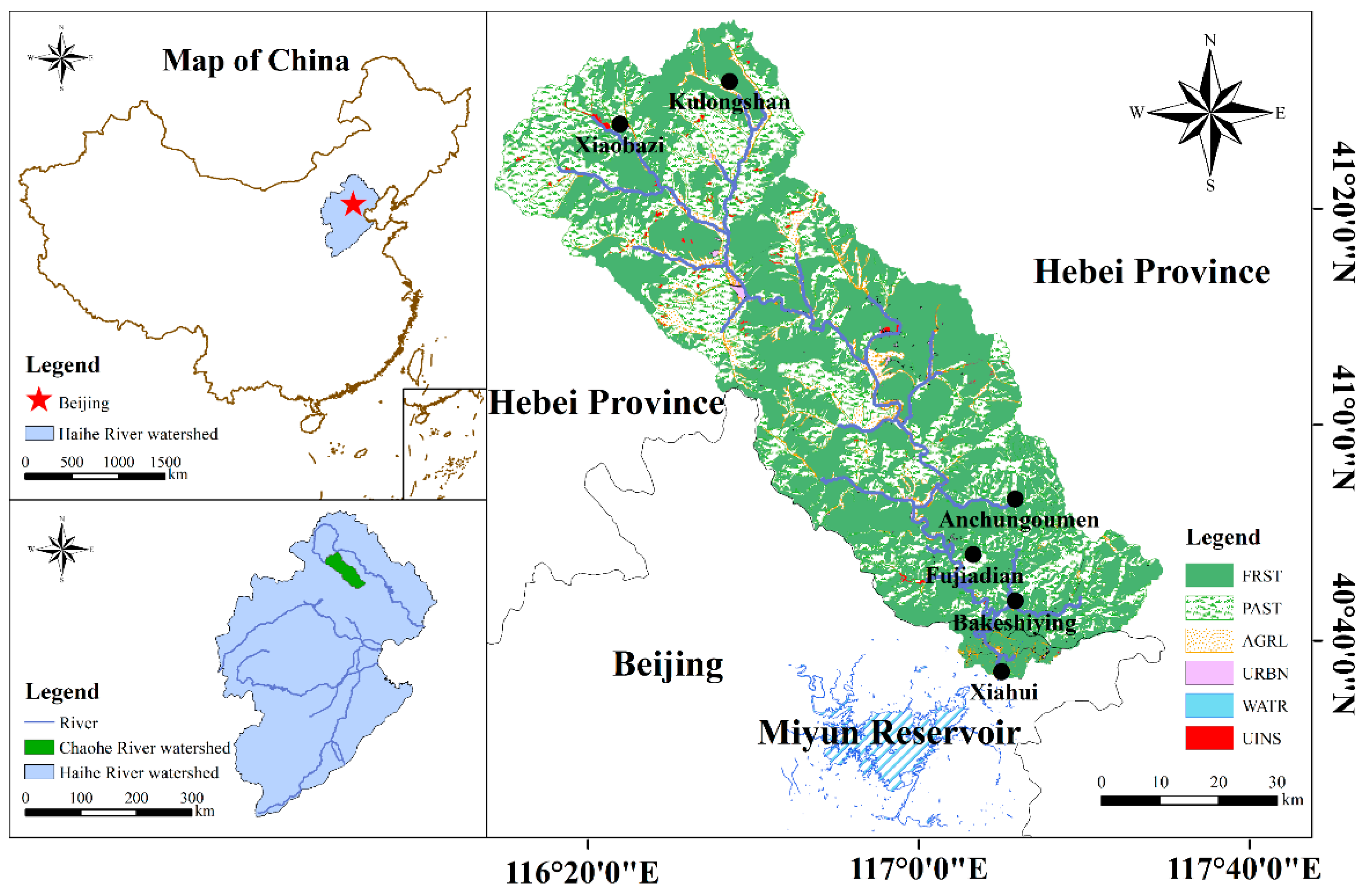
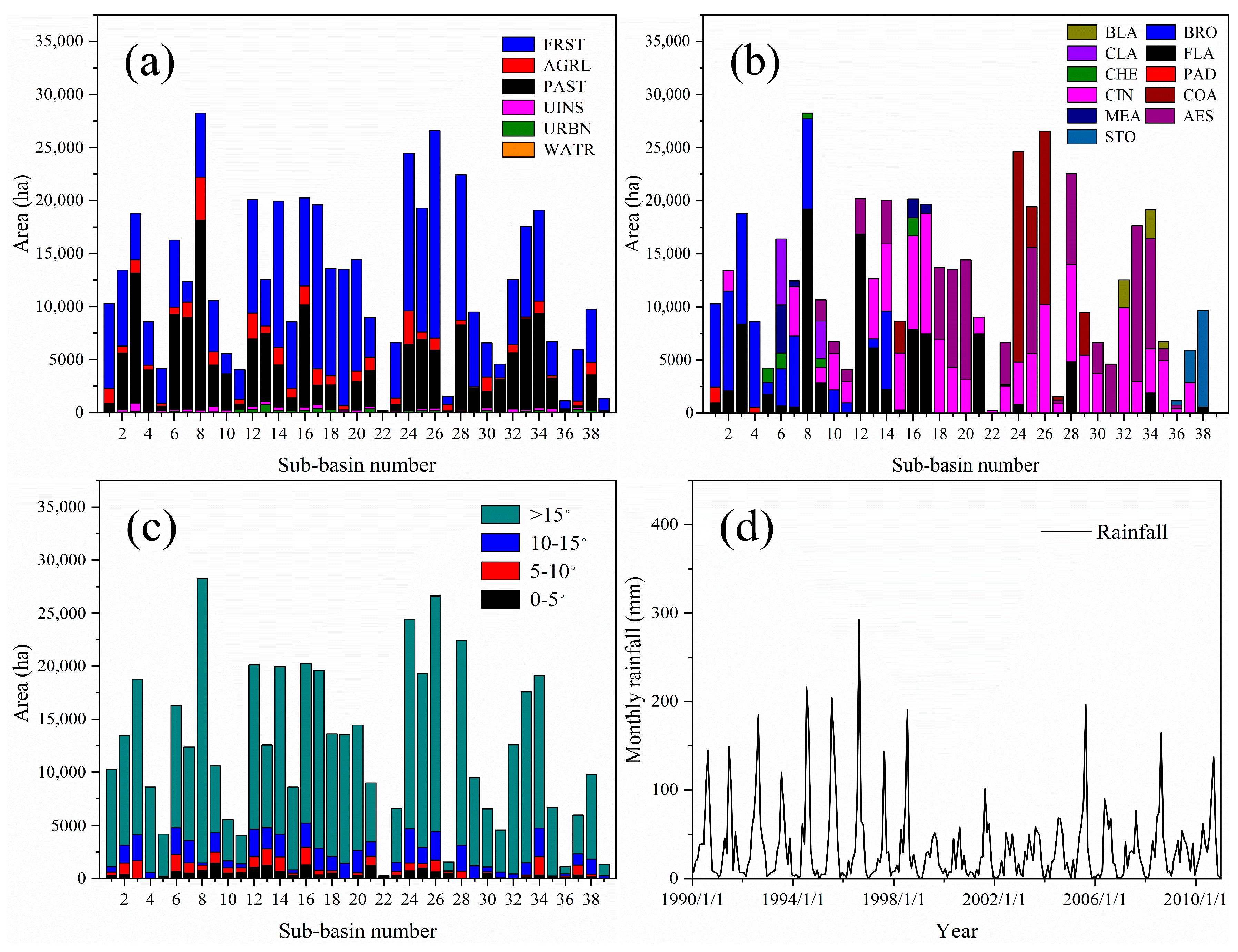
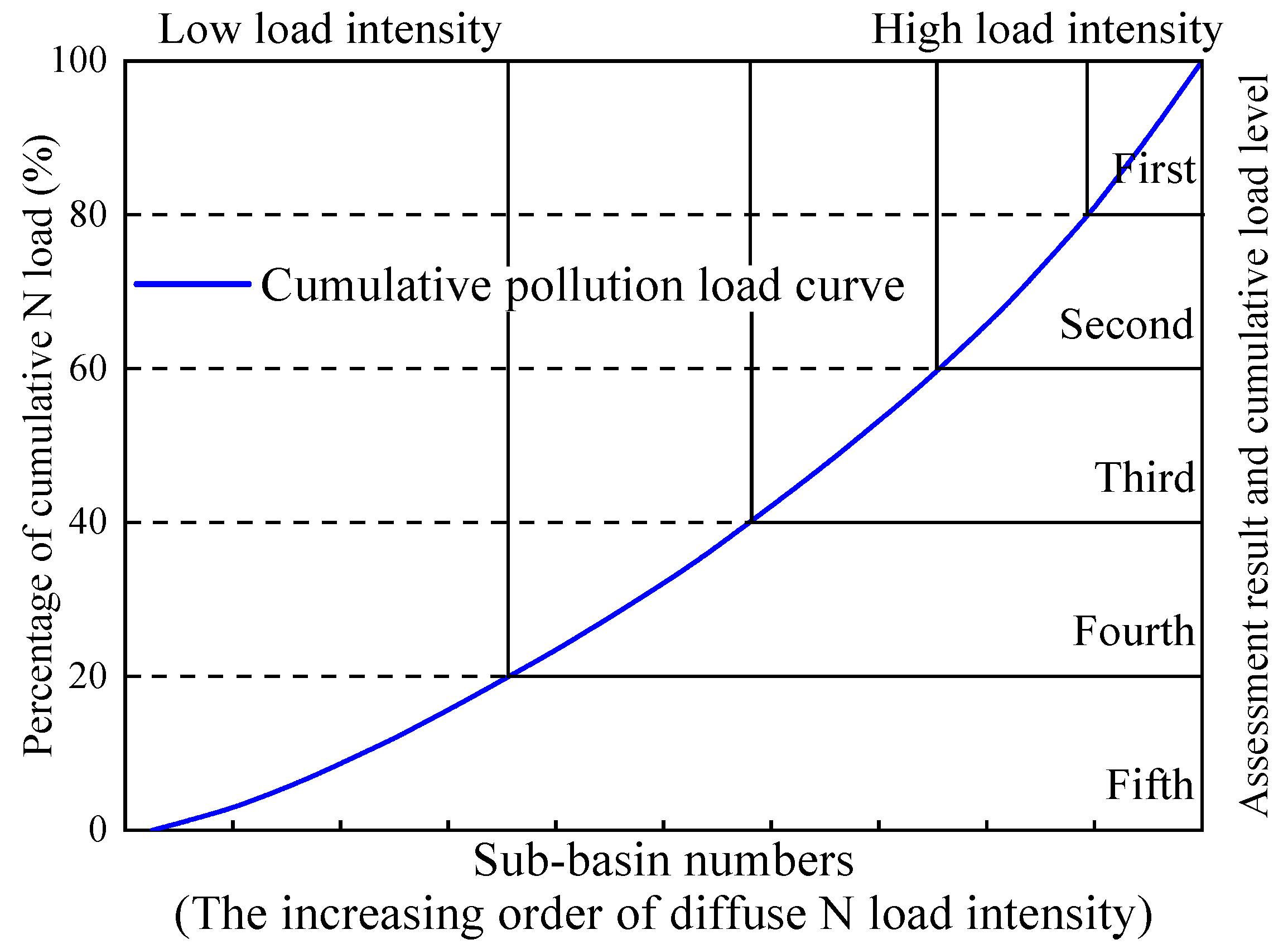

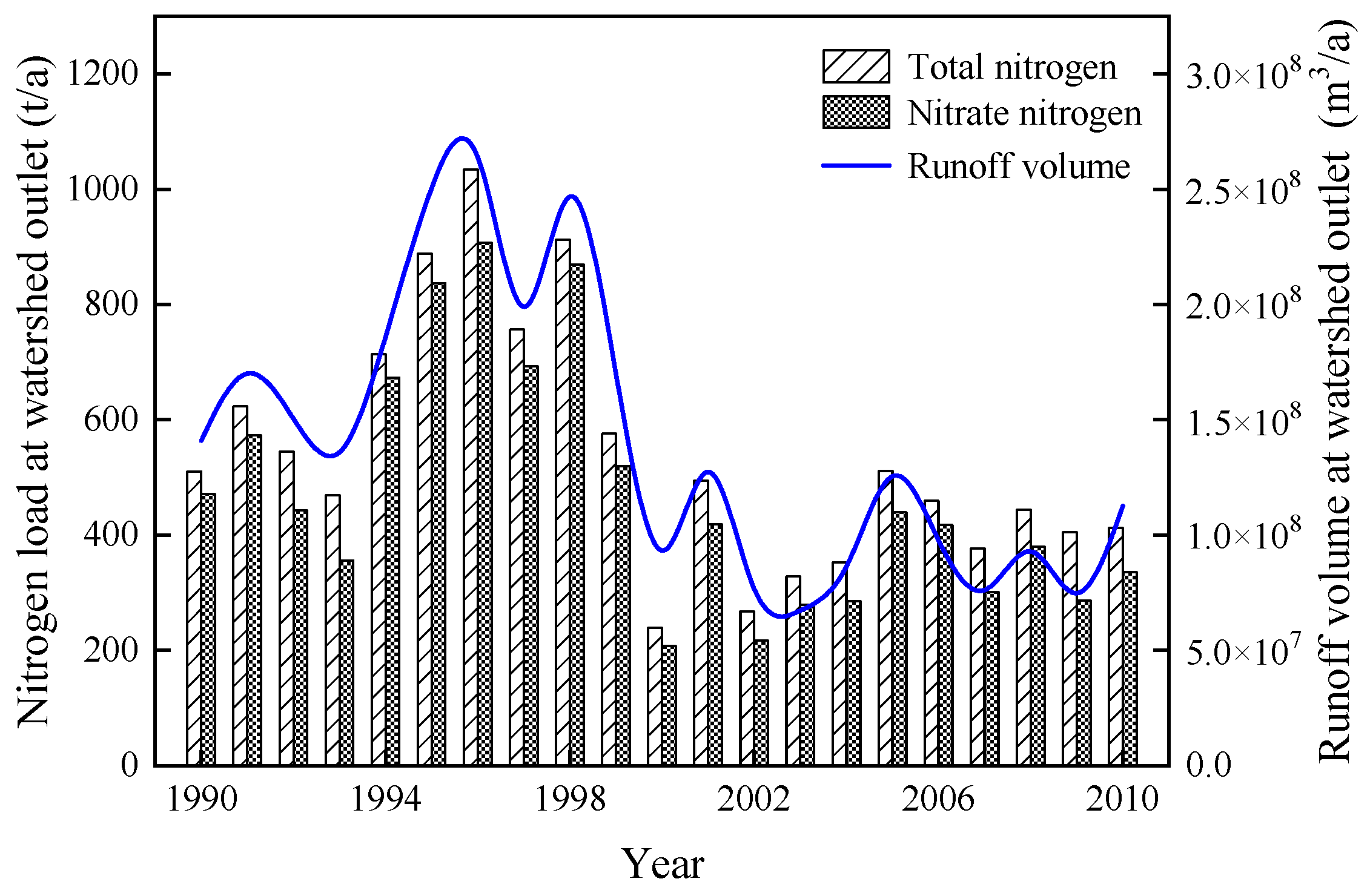
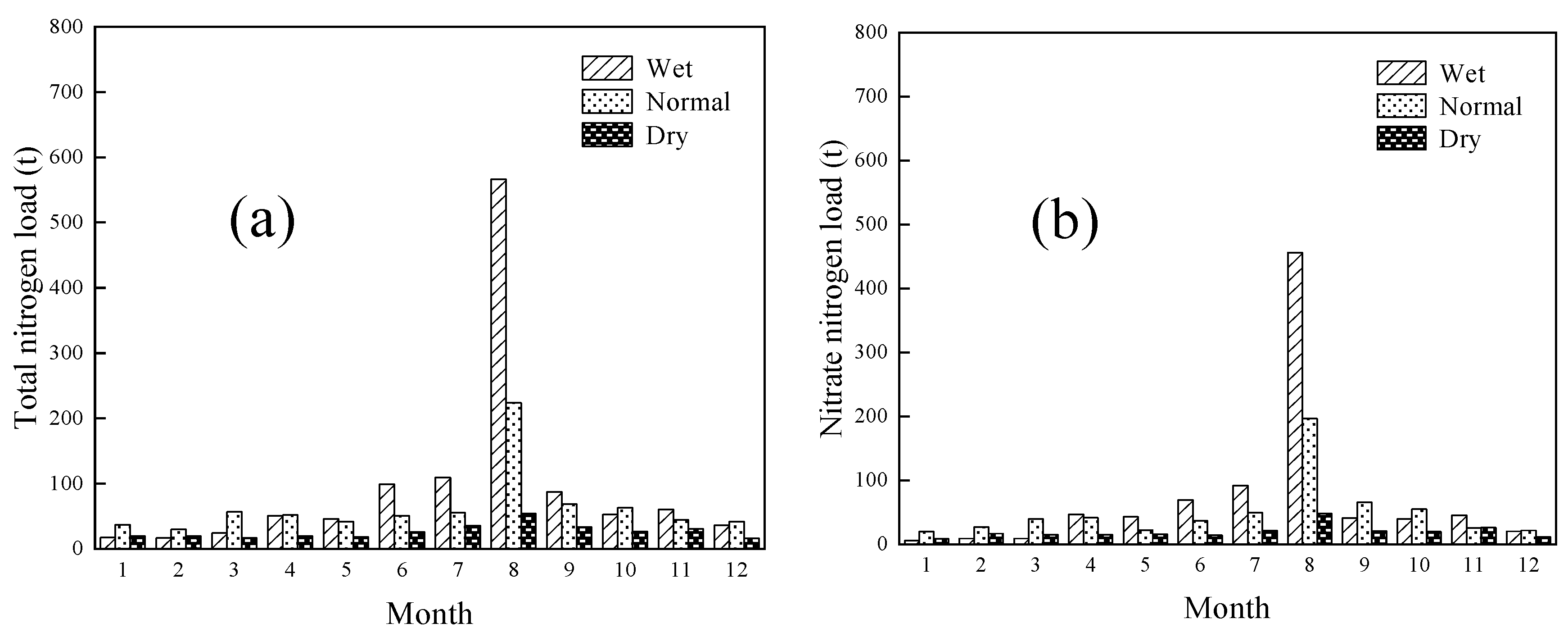

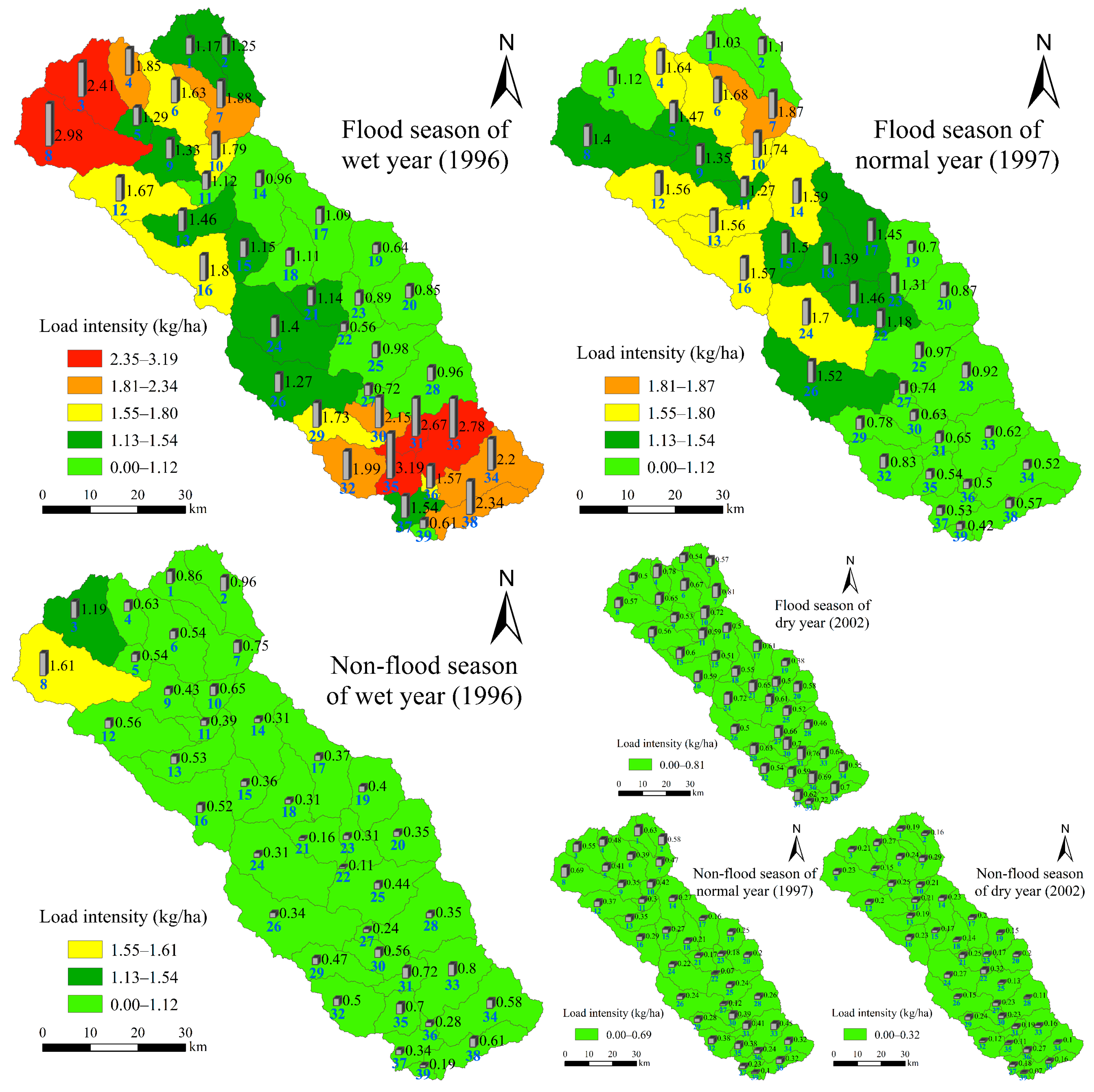

| Data Type | Scale | Data Description/Properties |
|---|---|---|
| DEM | 1:300,000 | Digital elevation model, grid size of 30 m × 30 m |
| Land use/cover (2000) | 1:100,000 | Land use classifications, scale of map |
| Soil map (2000) | 1:500,000 | Soil physical properties, scale of map |
| Climate data (1990–2010) | Daily | precipitation, temperature, solar radiation, wind speed, and relative humidity |
| Hydrology data (1990–2010) | Daily | From Xiahui Hydrological Monitoring Station |
| Water quality data (1990–2010) | Monthly | From Xiahui Hydrological Monitoring Station |
| Yearbook statistics (2000–2010) | Township | Socio-economic data, population data, livestock data |
| Variable | Parameter | Definition | Best Value | Sensitivity Ranking |
|---|---|---|---|---|
| Flow | ALPHA_BF | Baseflow alpha factor (days) | 0.685 | 1 |
| SOL_AWC | Available water capacity of the soil layer | 0.286 | 2 | |
| GWQMN | Threshold depth of water in the shallow aquifer required for return flow to occur (mm) | 2772.15 | 3 | |
| SOL_BD | Moist bulk density | 1.72 | 4 | |
| REVAPMN | Threshold depth of water in the shallow aquifer for “revap” to occur (mm) | 267.95 | 5 | |
| ESCO | Soil evaporation compensation factor | 0.568 | 6 | |
| ALPHA_BNK | Baseflow alpha factor for bank storage (days) | 0.305 | 7 | |
| CN2 | SCS moisture condition II curve number for previous areas | 55.30 | 8 | |
| CANMX | Maximum canopy storage | 83.79 | 9 | |
| SOL_K | Saturated hydraulic conductivity of the first layer (mm/hr) | 0.045 | 10 | |
| CH_K2 | Effective hydraulic conductivity in main channel alluvium | 228.99 | 11 | |
| EPCO | Plant uptake compensation factor | 0.349 | 12 | |
| GW_DELAY | Groundwater delay (days) | 118.61 | 13 | |
| TRNSRCH | Fraction of transmission losses from main channel that enter deep aquifer | 0.157 | 14 | |
| RCHRG_DP | Deep aquifer percolation fraction | 0.732 | 15 | |
| Total nitrogen and nitrate (NO3) nitrogen | NPERCO | Nitrogen (N) percolation coefficient | 0.493 | 1 |
| SOL_NO3 | Initial NO3 concentration in the soil layer | 15.78 | 2 | |
| SOL_ORGN | Initial organic N concentration in the soil layer | 56.24 | 3 | |
| FRT_KG | Amount of fertilizer applied to HRU (kg/ha) | 245.67 | 4 | |
| BC2 | Rate constant for biological oxidation of nitrite (NO2) to NO3 in the reach | 1.04 | 5 | |
| BC3 | Rate constant for hydrolysis of organic N to ammonium (NH4) in the reach | 0.362 | 6 | |
| ERORGN | Organic N enrichment ratio | 2.37 | 7 |
| Type of Region | Sub-Basins | PAST (ha) | AGRL (ha) | FRST (ha) | Total Area (ha) |
|---|---|---|---|---|---|
| First and second level CSAs | 3 | 12,294.64 | 1253.26 | 4365.25 | 18,782.1 |
| 8 | 17,890.12 | 4061.63 | 6044.55 | 28,246.41 | |
| 31 | 3023.06 | 144.99 | 1281.01 | 4569.39 | |
| 33 | 8535.7 | 169.38 | 8555.12 | 17,575.56 | |
| 35 | 2885 | 216.99 | 3189.19 | 6688.17 | |
| 4 | 3847.38 | 402.84 | 4130.58 | 8581.05 | |
| 7 | 8648.65 | 1407.78 | 1958.21 | 12,358.71 | |
| 30 | 1549.72 | 1357.45 | 3198.79 | 6559.65 | |
| 32 | 5271.85 | 777.03 | 6158.45 | 12,559.41 | |
| 34 | 8896.6 | 1151.38 | 8604.16 | 19,106.82 | |
| 38 | 3245.41 | 1165.24 | 5032.78 | 9761.22 | |
| Percentage of total area | 52.55% | 8.36% | 36.27% | 100% | |
| Potential pollution source areas | 6 | 8946.05 | 693.17 | 6344.42 | 16,284.42 |
| 10 | 3317.67 | 77.58 | 1900.44 | 5548.41 | |
| 12 | 6368.85 | 2408.04 | 10,728.81 | 20,105.55 | |
| 16 | 9608.14 | 1795.57 | 8317.09 | 20,258.37 | |
| 29 | 2272.05 | 105.66 | 7044.21 | 9480.51 | |
| 36 | 334.53 | 14.22 | 746.1 | 1134.54 | |
| Percentage of total area | 42.37% | 6.99% | 48.18% | 100% | |
| Low-risk source areas | 1 | 1014.33 | 1136.85 | 7990.65 | 10,274.85 |
| 2 | 5342.49 | 656.41 | 7172.78 | 13,443.48 | |
| 5 | 409.41 | 241.65 | 3336.57 | 4191.57 | |
| 9 | 3892.86 | 857.92 | 5231.66 | 10,566.27 | |
| 11 | 376.38 | 459.36 | 2825.19 | 4062.69 | |
| 13 | 6415.38 | 689.44 | 4393.76 | 12,549.87 | |
| 14 | 3960.52 | 1161.75 | 14,281.28 | 19,943.46 | |
| 15 | 1194.66 | 891.36 | 6277.5 | 8577.99 | |
| 17 | 1826.99 | 1237.46 | 15,773.09 | 19,612.08 | |
| 18 | 2281.31 | 881.01 | 10,098.91 | 13,587.21 | |
| 19 | 2.61 | 405.36 | 12849.3 | 13,516.29 | |
| 20 | 2681.72 | 685.86 | 10,824.07 | 14,437.26 | |
| 21 | 3380.49 | 1264.67 | 3747.16 | 8974.89 | |
| 22 | 0 | 100.53 | 92.34 | 243.18 | |
| 23 | 550.44 | 614.61 | 5221.26 | 6597.54 | |
| 24 | 6196.39 | 2565.92 | 15,462.09 | 24,446.88 | |
| 25 | 6519.59 | 664.68 | 11,712.76 | 19,304.73 | |
| 26 | 5451.55 | 1126.52 | 19,566.21 | 26,592.75 | |
| 27 | 73.71 | 589.68 | 782.19 | 1550.34 | |
| 28 | 8051.03 | 442.71 | 13,720.6 | 22,432.59 | |
| 37 | 146.7 | 440.37 | 4896.36 | 5975.1 | |
| 39 | 40.77 | 82.26 | 1129.23 | 1339.74 | |
| Percentage of total area | 22.81% | 6.56% | 67.65% | 100% |
| Impact Factors | Different Hydrological Years | ||
|---|---|---|---|
| Wet | Normal | Dry | |
| Rainfall | 0.801 ** | 0.784 ** | 0.795 * |
| Runoff | 0.782 * | 0.774 ** | 0.796 ** |
| Fertilization intensity | 0.878 ** | 0.856 ** | 0.902 ** |
| Grassland area ratio | 0.702 ** | 0.697 * | 0.676 ** |
| Cultivated land area ratio | 0.698 ** | 0.732 ** | 0.679 * |
| Forest area ratio | −0.598 * | −0.554 ** | −0.486 ** |
| Cinnamon area ratio | −0.175 | 0.106 | 0.027 |
| Fluvo-aquic soil area ratio | 0.214 | 0.297 | 0.176 |
| Aeolian sand area ratio | 0.532 * | 0.560 * | 0.529 * |
| Brown soil area ratio | 0.218 | 0.254 | 0.276 |
| 0–5° slope area ratio | 0.575 ** | 0.596 ** | 0.547 * |
| 5–10° slope area ratio | 0.646 ** | 0.606 ** | 0.580 ** |
| 10–15° slope area ratio | 0.013 | 0.096 | 0.154 |
| >15° slope area ratio | 0.667 ** | 0.675 * | 0.643 * |
© 2020 by the authors. Licensee MDPI, Basel, Switzerland. This article is an open access article distributed under the terms and conditions of the Creative Commons Attribution (CC BY) license (http://creativecommons.org/licenses/by/4.0/).
Share and Cite
Guo, Y.; Wang, X.; Zhou, L.; Melching, C.; Li, Z. Identification of Critical Source Areas of Nitrogen Load in the Miyun Reservoir Watershed under Different Hydrological Conditions. Sustainability 2020, 12, 964. https://doi.org/10.3390/su12030964
Guo Y, Wang X, Zhou L, Melching C, Li Z. Identification of Critical Source Areas of Nitrogen Load in the Miyun Reservoir Watershed under Different Hydrological Conditions. Sustainability. 2020; 12(3):964. https://doi.org/10.3390/su12030964
Chicago/Turabian StyleGuo, Yingzhuang, Xiaoyan Wang, Lili Zhou, Charles Melching, and Zeqi Li. 2020. "Identification of Critical Source Areas of Nitrogen Load in the Miyun Reservoir Watershed under Different Hydrological Conditions" Sustainability 12, no. 3: 964. https://doi.org/10.3390/su12030964
APA StyleGuo, Y., Wang, X., Zhou, L., Melching, C., & Li, Z. (2020). Identification of Critical Source Areas of Nitrogen Load in the Miyun Reservoir Watershed under Different Hydrological Conditions. Sustainability, 12(3), 964. https://doi.org/10.3390/su12030964




